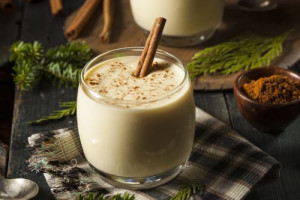Cinnamon
NEWS: This superfood is now available in the SANEStore as a convenient whole-food powder so you can more easily enjoy it in smoothies and recipes.
Cinnamon is one of the oldest and most recognizable of flavors in the world. Ancient Egyptians imported cinnamon from China and used it as a medicine and food enhancer. Since then it has been used in just about every type of food product available. The spice is obtained from the inner bark of the cinnamon tree. The bark rolls up while drying in the sun, and forms what we know as a cinnamon stick which is left as is or ground into a fine powder.

Preliminary lab and animal studies have found that cinnamon may have antibacterial and antifungal properties. It may also has an anti-clotting effect on the blood.
Several studies suggest that non-GMO cinnamon may have a supportive effect on blood sugar, making it possibly beneficial for people with Type 2 diabetes. Other studies with cinnamon showed an amazing ability to stop medication-resistant yeast infections. One study even found that smelling cinnamon may boost cognitive function and memory.

During research at Copenhagen University, patients given half a teaspoon of cinnamon powder combined with one tablespoon of honey every morning before breakfast had significant relief in arthritis pain after one week.
Studies have shown that just 1/2 teaspoon of cinnamon per day may possibly lower LDL cholesterol. In addition researchers at Kansas State University found that cinnamon fights the E. coli bacteria in unpasteurized juices. When added to food, it inhibits bacterial growth and food spoilage making it a natural food preservative.
Cinnamon is a great source of manganese, fiber, iron, and calcium.
[/av_textblock]
Sound Promising?
Want to Try Adding a Convenient and Pure Powdered Form of This Whole Food to Your Smoothies and Recipes?
Why Try Cinnamon Superfood?
- Supporting healthy cholesterol levels
- Relieving diarrhea
- Supports healthy digestion
- May Reduce headaches & migraine pain
- Supports cognitive function & memory
- Supports the immune system
- Anti-clotting effect on the blood
- Supporting healthy blood sugar levels
- Preserving foods
- Eliminating bad breath
- May Relieve in arthritis pain
- Ability to stop medication-resistant yeast infections
References
1. Braun, R. et al. 1997. Standardzulassungen für Fertigarzneimittel—Text and Kommentar. Stuttgart: Deutscher Apotheker Verlag
2. British Herbal Pharmacopoeia (BHP). 1996. Exeter, U.K.: British Herbal Medicine Association
3. Bruneton, J. 1995. Pharmacognosy, Phytochemistry, Medicinal Plants. Paris: Lavoisier Publishing
4. Der Marderosian, A. (ed.). 1999. The Review of Natural Products. St. Louis: Facts and Comparisons
5. Europäisches Arzneibuch, 3rd ed. (Ph.Eur.3). 1997. Stuttgart: Deutscher Apotheker Verlag
6. Grieve, M. 1979. A Modern Herbal. New York: Dover Publications, Inc.
7. The Homeopathic Pharmacopoeia of the United States (HPUS). 1992. Revision Service Official Compendium. Boston: Pharmacopoeia Convention of the American Institute of Homeopathy
8. Karnick, C.R. 1994. Pharmacopoeial Standards of Herbal Plants, Vol. 1. Delhi: Sri Satguru Publications. 94–95
9. Leung, A.Y. and S. Foster. 1996. Encyclopedia of Common Natural Ingredients Used in Food, Drugs, and Cosmetics, 2nd ed. New York: John Wiley & Sons, Inc.
10. List, P.H. and L. Hörhammer (eds.). 1973. Hagers Handbuch der Pharmazeutischen Praxis, 4th ed. Vol. 4. New York: Springer Verlag. 54, 884
11. Hänsel, R., K. Keller, H. Rimpler, G. Schneider (eds.). 1992. Hagers Handbuch der Pharmazeutischen Praxis, 5th ed. Vol. 4. Berlin-Heidelberg: Springer Verlag. 884
12. McGuffin, M., C. Hobbs, R. Upton, A. Goldberg. 1997. American Herbal Product Association’s Botanical Safety Handbook. Boca Raton: CRC Press
13. Newall, C.A., L.A. Anderson, J.D. Phillipson. 1996. Herbal Medicines: A Guide for Health-Care Professionals. London: The Pharmaceutical Press
14. Wichtl, M. and N.G. Bisset (eds.). 1994. Herbal Drugs and Phytopharmaceuticals. Stuttgart: Medpharm Scientific Publishers
15. Akira, T., S. Tanaka, M. Tabata. 1986. Pharmacological studies on the antiulcerogenic activity of Chinese cinnamon. Planta Med 52(6):440–443
16. Azumi, S., A. Tanimura, K. Tanamoto. 1997. A novel inhibitor of bacterial endotoxin derived from cinnamon bark. Biochem Biophys Res Commun 234(2):506–510
17. Braun, R. et al. 1997. Standardzulassungen für Fertigarzneimittel—Text and Kommentar. Stuttgart: Deutscher Apotheker Verlag
18. British Herbal Pharmacopoeia (BHP). 1983. Keighley, U.K.: British Herbal Medicine Association
19. Bruneton, J. 1995. Pharmacognosy, Phytochemistry, Medicinal Plants. Paris: Lavoisier Publishing
20. Chang, H.M. and P.P.H. But (eds.) 1986. Pharmacology and Applications of Chinese Materia Medica. Philadelphia: World Scientific. 510–514
21. Grieve, M. 1979. A Modern Herbal. New York: Dover Publications, Inc.
22. Hänsel, R., K. Keller, H. Rimpler, G. Schneider (eds.). 1992. Hagers Handbuch der Pharmazeutischen Praxis, 5th ed. Vol. 4. Berlin-Heidelberg: Springer Verlag
23. Hikino, H. 1985. Oriental Medicinal Plants. In: Wagner, H., H. Hikino, N.R. Farnsworth. 1985. Economic and Medicinal Plant Research, Vol. 1. London: Academic Press. 69–70
24. Leung, A.Y. and S. Foster. 1996. Encyclopedia of Common Natural Ingredients Used in Food, Drugs, and Cosmetics, 2nd ed. New York: John Wiley & Sons, Inc.
25. List, P.H. and L. Hörhammer (eds.). 1973. Hagers Handbuch der Pharmazeutischen Praxis, Vol. 4. New York: Springer Verlag. 54, 884
26. McGuffin, M., C. Hobbs, R. Upton, A. Goldberg. 1997. American Herbal Product Association’s Botanical Safety Handbook. Boca Raton: CRC Press
27. Nadkarni, K.M. 1976. Indian Materia Medica. Bombay: Popular Prakashan. 328–330
28. Newall, C.A., L.A. Anderson, J.D. Phillipson. 1996. Herbal Medicines: A Guide for Health-Care Professionals. London: The Pharmaceutical Press
29. Tu, G. (ed.). 1992. Pharmacopoeia of the People’s Republic of China (English Edition 1992). Beijing: Guangdong Science and Technology Press. 31
30. Tyler, V.E., L.R. Brady, J.E. Robbers. 1988. Pharmacognosy , 9th ed. Philadelphia: Lea & Febiger. 119–122
31. Yen, K.Y. 1992. The Illustrated Chinese Materia Medica—Crude and Prepared. Taipei: SMC Publishing, Inc.
32.http://www.naturalnews.com/045969_cinnamon_bark_Parkinsons_disease_Chinese_medicine.html
33. http://www.rush.edu/webapps/MEDREL/servlet/NewsRelease?id=1768
34. http://www.ibtimes.co.in/cinnamon-may-help-treat-parkinsons-disease-study-604144
35. http://www.naturalnews.com/043510_cinnamon_Alzheimers_disease_blood_pressure.html
36. http://www.naturalnews.com/031133_cinnamon_diabetes.html
37. http://science.naturalnews.com/cinnamon.html
38. Zhongshan Medical College Editorial Group (ZMC). 1975. Clinical Application of Chinese Traditional Drugs, 1st ed. Guangdong: Guangdong People’s Publishing House. 8, 201








